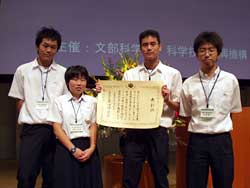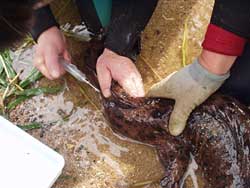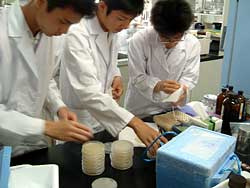|
MONTHLY NEWS Decoding the Blueprint of Life | ||||||||||||
A high school in Hiroshima City has accomplished a world first in DNA decoding. Its students have won praise not only for conducting this research but also for presenting their findings to groups of expert scientists. The school is Kokutaiji High School in Hiroshima Prefecture. It is one of the Super Science High Schools (SSH) designated by the Ministry of Education, Culture, Sports, Science, and Technology (MEXT), where students are given an opportunity to study science at an advanced level. Here, students use the same type of hi-tech experimental laboratories as those found at universities. In these labs, they conduct experiments and research in uncharted fields not found in textbooks.
In August 2004, Kokutaiji High School received the top prize among awards that are given to SSHs that conduct outstanding research. The school won for its students' work in decoding all 16,000 of the base sequences of mitochondrial DNA in a lizard-like animal called the giant salamander. The students were quite familiar with the giant salamander, a rare amphibian that is designated as a special national treasure in Japan. The animal is beloved of Hiroshima residents, and it was a zoo in the city that achieved the first successful artificial reproduction of the animal. Genetic information is known as the "blueprint of life." It is imprinted in the DNA (deoxyribonucleic acid) contained in the cells of all living organisms, including humans. DNA is comprised of two strands of four different types of base molecules. The "blueprint of life" is determined based on the way these molecules are aligned (sequenced). The DNA that the high school students mapped is contained in mitochondria, which are a type of organelle within cells. Mitochondrial DNA provides us with particularly important clues in researching how living organisms evolved.
As part of an extracurricular science course, the students, with the help of Hiroshima University, used a decoding device called a sequencer, and over the course of a year and a half they succeeded in decoding the DNA. They then presented their results to academic groups, including the Society of Evolutionary Studies, Japan, the Genetics Society of Japan, and the Herpetological Society of Japan. Achieving a world first may sound glamorous, but the process of decoding the DNA involved tedious, repetitive labor. The students were also responsible for maintaining the equipment, and they had to read difficult research papers and put in extra study on top of their regular schoolwork. "Researchers need to be tenacious. The work is tedious, but the students worked hard toward their ambitious goal of achieving a world first. They studied beyond the framework of the class and pursued their dream. They have a great sense of achievement, and the number of students who hope to become biologists has increased," said Taruma Akinori, who is in charge of the science course. In addition to the results being entered into an international database, the students' research paper will be translated into English and made available overseas. Moreover, the students have decided to take on a new challenge in DNA decoding. Kokutaiji High School is also doing a lot of remarkable work besides DNA mapping, and it recently received the silver prize at the All-Japan High School Chemistry Grand Prix. With accomplishments like these, it would be no surprise if one day a Nobel Prize winner were to emerge from the school. |
 |


